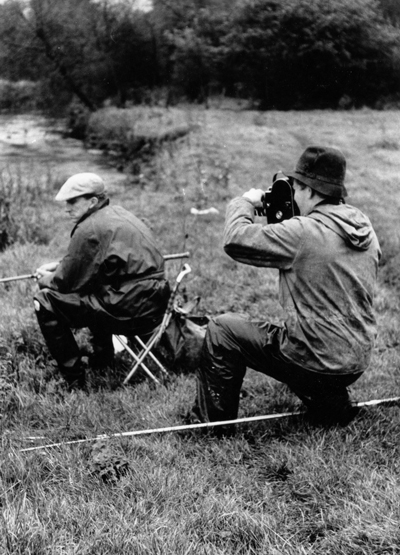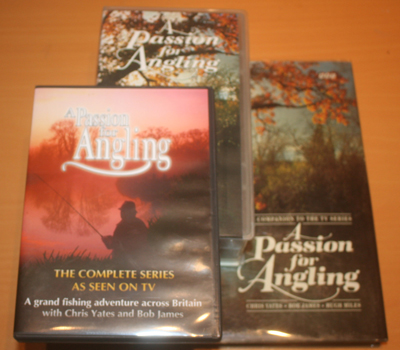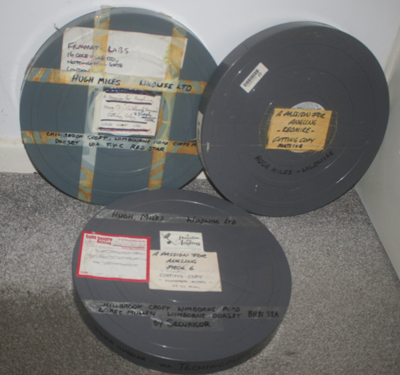Although in this digital age we take films for granted and everyone can capture images on their phone or camera, it was not that long ago that fishing footage was very rare and of poor quality.
Without doubt, in the world of angling, the film that changed everything was A Passion for Angling produced by Hugh Miles and featuring Chris Yates and Bob James.
 The inspiration for the film was Hugh Miles’ love of fishing. He grew up in an artistic family: his father was an orchestra leader/conductor and Hugh was a talented French Horn player. On finishing school he went to Art College and the first film that he produced for the course featured the legendary pike angler, Dennis Pye who Hugh remembers catching big pike virtually to order. He later made films called Tackle and Tactics again featuring Dennis Pye and Peter Stone (pictured).
The inspiration for the film was Hugh Miles’ love of fishing. He grew up in an artistic family: his father was an orchestra leader/conductor and Hugh was a talented French Horn player. On finishing school he went to Art College and the first film that he produced for the course featured the legendary pike angler, Dennis Pye who Hugh remembers catching big pike virtually to order. He later made films called Tackle and Tactics again featuring Dennis Pye and Peter Stone (pictured).
Hugh had talked about making a film with Richard Walker but joined the BBC as a cameraman on series including Z cars and Morecambe and Wise before working with David Attenborough on many of his nature programmes. Hugh worked for the RSPB before making his own series of films including ‘Flight of the Condor’ and ‘Kingdom of the Ice Bear’ winning Emmy’s in the States amongst many other global awards.
However, he always had a burning desire to make a film about fishing and 25 years later and his wish was became reality. Quite by chance he met Bob James and Chris Yates over a cup of tea and conversation quickly turned to angling and making a film. With their personalities and contrasting style; Chris using vintage tackle whereas Bob used state of the art techniques, it was felt it would have broader appeal not only to anglers, but also to non-anglers as it demonstrated why people love fishing.
So talk progressed about making a one-off programme which Hugh decided should be filmed all by himself to try and capture the intimacy of the anglers in their surroundings. However, in 1989, their plan got more ambitious and what had begun as an idea for one programme became a series of six.
The 1990 fishing season had yet to open and it was decided that Redmire, where Chris had caught the record 51lb carp known as ‘The Bishop’, was the ideal place and they budgeted £1000 to spend at auction to have exclusive fishing on the opening week. Hugh later learned that they had paid £2000 and during the same week of the previous year no fish were caught there!
They arrived at Redmire on the Welsh borders, four days before the season opened in order to get background shots, and to build a hide to help film the fauna and flora so necessary to help capture a significant part of the essence of the programme. Fortunately, Hugh was also able to film the excitement of four 20lb carp being caught; big fish back in those days. This coupled with Chris Yates legendary quirkiness using Kevin the Scarecrow and fishing out of trees added a touch of humour to the proceedings.
Chris, not renowned for being an early bird, joked that he could never work with Hugh again. He is such a perfectionist that he got him out of bed at 2 am on successive days to get the shot he wanted. He did so because all the conditions had to be the same as the other film clips he had made to ensure they blended in seamlessly .
 This became the first filmed in the series of six programmes although the first one screened was ‘Childhood Dreams’, which encapsulated the thrill of youngsters when they catch the tiniest of fish.
This became the first filmed in the series of six programmes although the first one screened was ‘Childhood Dreams’, which encapsulated the thrill of youngsters when they catch the tiniest of fish.
In all it took three years to complete being broadcast in 1993 and was undoubtedly groundbreaking having been produced by a world class film maker. It is far and away the best angling film of its era (or should that be wildlife film). It set new standards of what was expected, and even non-anglers having watched it, expressed their enjoyment of the series
Since then, times have changed and with the advent of You tube. People load copies of such programmes on line without realising the effect they are having. Everyone can now access the films in this way without purchasing DVD’s and so have taken money away from film makers like Hugh who spend years on films of this quality. While technology has reduced the expense of the film manufacturing process, film makers can still take years to be in the right place to get the best results. Without the proceeds from DVD sales, programmes of this quality may never be produced again due to lack of funds.
(Hugh Miles has donated the original acetate films of the series which are now preserved by Angling Heritage.)

Keith Armishaw